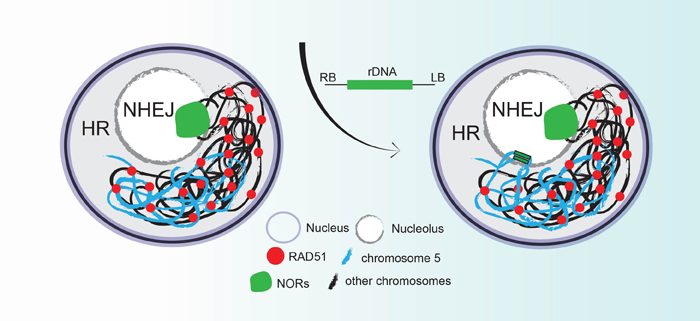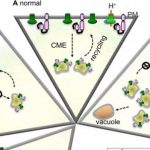The nucleolus protects the repetitive rDNA during meiosis
Sims et al. examine the mechanisms protecting the highly repetitive ribosomal DNA from double-strand break formation and homologous repair during meiosis. https://doi.org/10.1105/tpc.19.00367
Background: Meiosis is a specialized cell division in sexually reproducing organisms, where one round of DNA replication is followed by two cell divisions. This generates gametes with half the genetic content. Importantly, genetic information recombines during meiosis, leading to novel trait combinations. To accomplish this, the cell’s sophisticated protein machinery introduces DNA double-strand breaks (DSBs) across the genome—these DSBs then initiate homologous recombination (HR), a mode of DNA repair that allows the broken DNA ends to engage with undamaged templates on other chromosomes. This works well in most genomic regions, but becomes problematic in repetitive regions, where HR may engage with any of the available repeat sequences. This could lead to unequal distribution or loss of repetitive elements—a particular problem for repetitive DNA sequences with essential functions, like the rDNA, which produces the RNA subunits of ribosomes. The number of rDNA genes needs to be maintained in a tight, organism-specific window over many generations and therefore, unequal recombination or gene loss could damage the organism.
Question: What protects the rDNA genes from meiotic DSB formation and HR?
Findings: Using the model plant Arabidopsis thaliana, we demonstrate that all rDNA repeats become transcriptionally active and are recruited into the nucleolus early in meiosis. The nucleolus is a sub-nuclear structure that houses a sub-fraction of rDNA repeats in somatic cells and is the place of rRNA gene transcription and ribosome subunit assembly. This meiotic recruitment shields the rDNA from acquiring canonical meiotic chromatin modifications, meiotic cohesin and meiosis-specific DSBs. DNA lesions within the rDNA are repaired by non-homologous end joining (NHEJ) maintaining rDNA integrity during meiosis. This is the first time that NHEJ is shown to have an active role during meiosis.
Next Steps: In our initial study, we used an engineered a single rDNA repeat to measure its effect on meiotic recombination frequencies. In the future we aim to analyze the endogenous rDNA clusters. To perform such analysis, we are currently sequencing the repetitive rDNA clusters, which are to date still terra incognita.
Jason Sims, Gregory P. Copenhaver and Peter Schlögelhofer (2019) Meiotic DNA Repair in the Nucleolus Employs a Non-homologous End Joining Mechanism. Plant Cell. https://doi.org/10.1105/tpc.19.00367
Key words: meiosis, recombination, ribosomal DNA.




